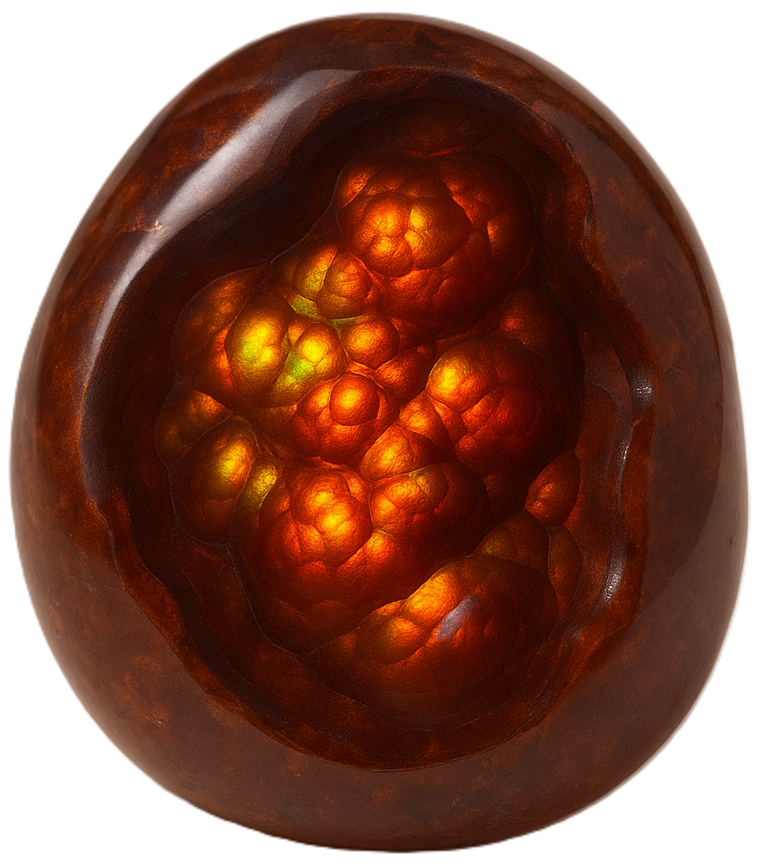
Fire Agate derives its name from the mesmerising iridescent flashes that seem to flicker like flames within its depths. The word agate originates from the Greek Achates, the name of a river in Sicily where agates were first discovered. Sometimes referred to as “Iris Agate” or “Fiery Chalcedony,” Fire Agate stands out as one of the most captivating varieties of the agate family due to its radiant, fire-like glow.
Composition and Physical Characteristics
Fire Agate is a microcrystalline variety of quartz belonging to the chalcedony group, with a chemical composition of silicon dioxide (SiO₂). It exhibits a unique layered structure in which thin films of iron oxide (hematite or limonite) or goethite form between layers of silica. These microscopic inclusions cause interference and diffraction of light, creating the gemstone’s characteristic iridescent “fire.”
Hardness: 6.5–7 on the Mohs scale
Lustre: Waxy to vitreous
Transparency: Translucent to opaque
Colour Range: Brown, red, orange, gold, green, and occasionally blue iridescence
Each Fire Agate is truly unique, as the pattern and intensity of its fiery flashes vary from stone to stone.
Varieties of Fire Agate
While Fire Agate is a specific form of chalcedony, it is often classified by the region of its discovery or its dominant colour tones:
- Mexican Fire Agate: The most famous and vividly coloured, found primarily in Chihuahua and Aguascalientes.
- Arizona Fire Agate: Displays deeper earthy browns with rich red and gold flashes.
- Slaughter Mountain Fire Agate: Highly prized for its vibrant green and gold hues, found on Apache lands in Arizona.
Geographical Locations
Fire Agate is relatively rare compared to other agates. It is found almost exclusively in arid regions of Mexico (Chihuahua, Aguascalientes, San Luis Potosí) and the south-western United States, particularly Arizona, California, and New Mexico. Small deposits have also been identified in Brazil, Indonesia, and Australia, but these are less significant.
Archaeological and Significant Finds
Fire Agate has been used by indigenous peoples of North and Central America for thousands of years. Early civilisations are believed to have used it in ceremonial tools, jewellery, and protective amulets. In the 20th century, the stone gained commercial recognition when deposits in Arizona and Mexico were mined and cut for the gem and lapidary markets.
Significant finds continue to emerge in the Slaughter Mountain region, where Fire Agate is often extracted with deep cultural and spiritual respect by the Apache people.
Historical and Current Usage
Historically, Fire Agate was considered a stone of spiritual protection and courage, believed to ward off evil spirits and negative energy. Today, it remains a favourite among crystal healers, jewellers, and collectors for its intense energy and captivating appearance.
It is commonly used in:
- Jewellery: Cabochons, pendants, and rings.
- Meditation and energy work: To ignite passion and motivation.
- Decorative items: Carvings and ornamental displays.
Interesting Facts
- Each Fire Agate’s “fire” is entirely natural — it is not enhanced or treated.
- The iridescence is caused by light interference within the thin layers of iron oxides, much like the colours seen in butterfly wings or peacock feathers.
- Due to its rarity and complexity, Fire Agate is often dubbed the “Spiritual Flame of Absolute Perfection.”
Folklore, Superstition, Legends and Tales
Ancient legends tell of Fire Agate being created during times of intense volcanic activity, believed to have captured the essence of fire within the Earth. Native American tribes regarded it as a gift from the gods of fire, used to provide protection and to strengthen the warrior spirit.
Folklore also attributes Fire Agate with the ability to reflect ill wishes back upon the sender, making it a talisman of spiritual shield and justice.
Mystical Healing Properties
Fire Agate is a powerful stone of vitality, grounding, and protection. It stimulates the flow of life force energy throughout the body, encouraging passion, creativity, and physical stamina.
Key healing attributes include:
- Emotional: Dispels fear, insecurity, and lethargy. Promotes courage, confidence, and enthusiasm.
- Spiritual: Acts as a grounding stone while enhancing spiritual awakening and inner security.
- Physical: Believed to assist in improving circulation, digestion, and energy metabolism.
It is also said to aid in rekindling lost passion and motivation in both personal and professional pursuits.
Astrology and the Zodiac
Fire Agate resonates strongly with Aries, Leo, and Sagittarius — all fire signs that share its dynamic energy. It enhances their natural enthusiasm and determination while offering protection against impulsive tendencies.
For Scorpio, it assists in emotional grounding and control of inner intensity.
The Chakra System
Fire Agate aligns primarily with the Root Chakra (Muladhara) and Sacral Chakra (Svadhisthana). It grounds the individual’s energy to the Earth, creating a sense of stability and safety, while stimulating the creative and sexual energies of the Sacral Chakra. Its warming vibration can also activate the Solar Plexus Chakra, empowering confidence and personal will.
Birthstone and Wedding Anniversary Use
Although not a traditional birthstone, Fire Agate is often associated with those born under the element of Fire and is a meaningful alternative birthstone for Aries and Leo.
It is sometimes gifted for the 6th wedding anniversary, symbolising enduring passion, vitality, and protection in love.
Crystal Combinations — Which Work Well and Which to Avoid
Works well with:
- Carnelian – to enhance creativity and motivation.
- Hematite – for grounding and stability.
- Sunstone – to boost joy and vitality.
- Red Jasper – for emotional endurance and courage.
Avoid pairing with:
- Blue Lace Agate or Selenite – their calming and cooling energies may dampen Fire Agate’s fiery motivation.
- Labradorite – its mystical yet shifting energies can clash with Fire Agate’s grounded focus.
